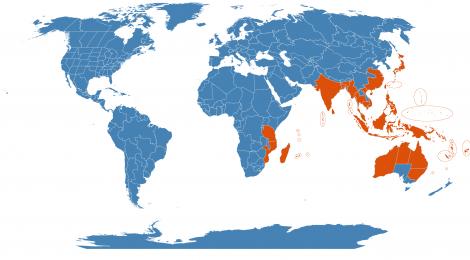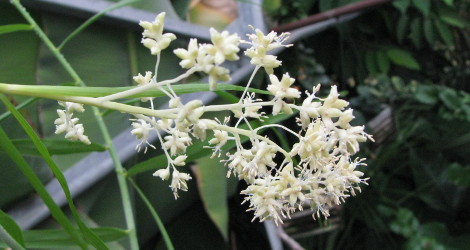Accession Data:
Flagellaria indica L.
- Common Name: Supplejack, Whip vine
- Family: Flagellariaceae Dumort.
- Country of Origin: S. Tanzania to Mozambique and W. Pacific

- Habitat: notophyll rainforest, along scrubby watercourses & littoral rainforest
- Description: Simple linear light green leaves have a base that encloses the stem and drawn out leaf tips that form narrow coiled tendrils. Has formless extrafloral nectaries that secrete nectar, mainly through stomata, in the leaf sheaths that are tightly pressed against the stem.
Plants perennial. Leaf sheath 2-7 cm; pseudopetiole 3-8 mm, abaxially flattened; leaf blade lanceolate to linear, 7-25 × 0.5-2 cm, base abruptly contracted, rounded, or slightly cordate. Panicles erect, irregularly branched, dense; bracts short, broad. Flowers small; tepals white, ovate to broadly so, 2--3 mm, thinly membranous. Stamens exserted. Ovary narrow. Drupes reddish when mature, globose, 4-6 mm in diam., smooth. Seeds 1(or 2). Fl. Apr-Jul, fr. Sep-Nov.4
- Uses: Aborigines had many uses for this vine, including using the astringent leaves to heal wounds. Tips (sap) applied to sore eyes and also used as contraceptive. Used as rope for tree climbing. Woven into fish traps and nets.
- IMPORTANT NOTE: Plant Uses are for informational purposes only. EEB Greenhouses assume no responsibility for adverse effects from the use of any plants referred to on this site. Always seek advice from a professional before using any plant medicinally.
- Culture: Difficult to propagate from cuttings, resents root disturbance and hard pruning.
Accession Data:
- Accession # 200500017
- Source: Joan Leonard - Ohio State
- Accession Date: 04-07-2005
- Bench: 1118 - AFR:Ground Bed 2 SW
- Currently: active - healthy
- Qty: 1 confirmed on 02-26-2025
Classification:
- Division: Magnoliophyta
- Class: Liliopsida
- SubClass: commelinids
- Order: Poales
- SubOrder:
- Family: Flagellariaceae
- SubFamily:
- Tribe:
- SubTribe:
Flowering Data:
This accession has been observed in bloom on:| Year | Jan | Feb | Mar | Apr | May | Jun | Jul | Aug | Sep | Oct | Nov | Dec | ||||||||||||||||||||||||||||||||||||||||
|---|---|---|---|---|---|---|---|---|---|---|---|---|---|---|---|---|---|---|---|---|---|---|---|---|---|---|---|---|---|---|---|---|---|---|---|---|---|---|---|---|---|---|---|---|---|---|---|---|---|---|---|---|
| 2025 | ||||||||||||||||||||||||||||||||||||||||||||||||||||
| 2024 | ||||||||||||||||||||||||||||||||||||||||||||||||||||
| 2023 | ||||||||||||||||||||||||||||||||||||||||||||||||||||
| 2022 | ||||||||||||||||||||||||||||||||||||||||||||||||||||
| 2021 | ||||||||||||||||||||||||||||||||||||||||||||||||||||
| 2020 | ||||||||||||||||||||||||||||||||||||||||||||||||||||
| 2019 | ||||||||||||||||||||||||||||||||||||||||||||||||||||
| 2018 | ||||||||||||||||||||||||||||||||||||||||||||||||||||
| 2017 | ||||||||||||||||||||||||||||||||||||||||||||||||||||
| 2016 | ||||||||||||||||||||||||||||||||||||||||||||||||||||
| 2015 | ||||||||||||||||||||||||||||||||||||||||||||||||||||
| 2014 | ||||||||||||||||||||||||||||||||||||||||||||||||||||
| 2013 | ||||||||||||||||||||||||||||||||||||||||||||||||||||
| 2012 | ||||||||||||||||||||||||||||||||||||||||||||||||||||
| 2011 | ||||||||||||||||||||||||||||||||||||||||||||||||||||
| 2010 | ||||||||||||||||||||||||||||||||||||||||||||||||||||
| 2009 | ||||||||||||||||||||||||||||||||||||||||||||||||||||
| 2008 | ||||||||||||||||||||||||||||||||||||||||||||||||||||
References (internal):
- EEB Greenhouse Holdings native to: Tanzania / Mozambique / Mauritius / Madagascar / Reunion / Rodrigues / Seychelles / Hainan / China Southeast / Japan / Nansei-shoto / Taiwan / Assam / Bangladesh / India / Maldives / Sri Lanka / Andaman Is. / Cambodia / Myanmar / Nicobar Is. / Thailand / Vietnam / Borneo / Jawa / Lesser Sunda Is. / Malaya / Maluku / Philippines / Sulawesi / Sumatera / Bismarck Archipelago / New Guinea / Solomon Is. / Norfolk Is. / New South Wales / Northern Territory / Queensland / Western Australia / Fiji / New Caledonia / Santa Cruz Is. / Vanuatu / Wallis-Futuna Is. / Caroline Is. / Marianas
References (external):
- Brisbane Rainforest Action & Information Network
- The Plant List (2013). Version 1.1. Last accessed on Friday, July 21, 2017.
- WCSP (2016). World Checklist of Selected Plant Families. Facilitated by the Royal Botanic Gardens, Kew. Last accessed on Friday, July 21, 2017.
- Flagellaria indica at Flora of China. Last accessed on Saturday, 22 December 2018.
data regenerated on Wed, 26 Feb 2025 11:42:33 -0500 [bcm v4.0]
Images:

Additional images for this accession:
Click on thumbnails to enlargeCurrent Accessions in the Flagellariaceae
W/C = Wild Collected = indicates flowering in past 14 days
= indicates flowering in past 14 days
 = images available for this accession
= images available for this accession
 = map available for this accession
= map available for this accession
 = accession added within past 90 days
= accession added within past 90 days


